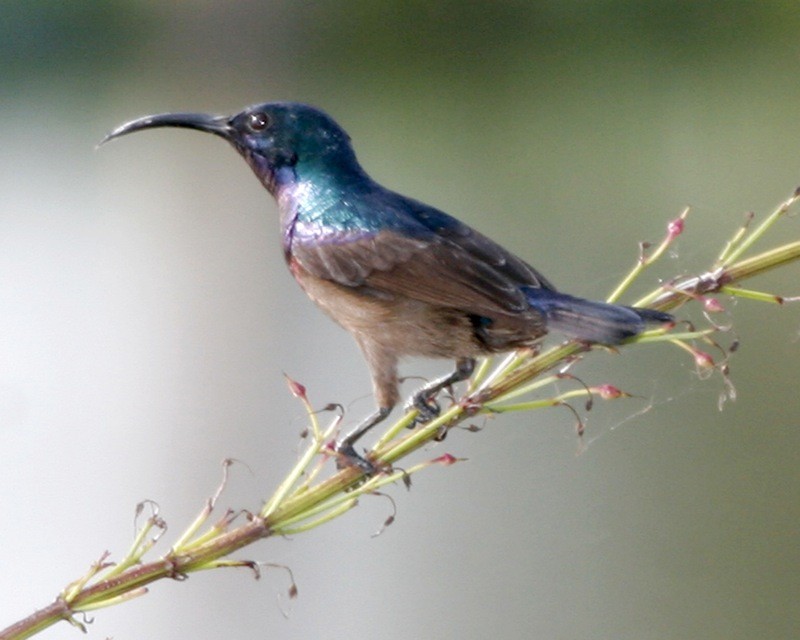Loten's Sunbird
A species of Double-collared Sunbirds and Allies Scientific name : Cinnyris lotenius Genus : Double-collared Sunbirds and Allies
Loten's Sunbird, A species of Double-collared Sunbirds and Allies
Botanical name: Cinnyris lotenius
Genus: Double-collared Sunbirds and Allies
Content
Description General Info
 Photo By Lip Kee , used under CC-BY-SA-2.0 /Cropped and compressed from original
Photo By Lip Kee , used under CC-BY-SA-2.0 /Cropped and compressed from original Description
Loten's sunbirds are small, only 12–13 cm long. The long bill separates this from the syntopic purple sunbird. The wings are browner and the maroon breast band is visible on the male under good lighting conditions. The males have pectoral tufts of yellow mixed with crimson that are used in displays. The adult male is mainly glossy purple with a grey-brown belly. The female has yellow-grey upperparts and yellowish underparts, but lacks the purple's faint supercilium. The call is distinctive buzzy zwick zwick and they are also very active often bobbing their head while foraging. They long down-curved bills and brush-tipped tubular tongues, are adaptations to their nectar feeding. The bill lengths vary across populations with the longest bills are found on the east of Peninsular India and in Sri Lanka. The song of the male is a long repeated wue-wue-wue... with the last notes accelerated. The song has been likened to the call of the cinereous tit. The males may sing from the tops of bare trees or telegraph wires. The male in winter has an eclipse plumage with a yellowish underside resembling that of the female but having a broad central streak of dark metallic violet from the chin to the belly. The existence of an eclipse plumage in the adult male has been questioned by Rasmussen & Anderton (2005) due to the lack of specimens in evidence. Jerdon noted however that: A specimen in the Museum As. Soc., Calcutta, has the winter or currucaria plumage of the last, viz., a central glossy green stripe on the throat and breast, and a spot on the shoulders of the wings; otherwise as in the female. I do not recollect seeing the bird in this plumage in Malabar, where I had many opportunities of observing it, and rather think that it must have been a young bird. 
Size
13 cm
Colors
Brown
Black
Green
Yellow
Gray
Blue
Purple
Nest Placement
Tree
Feeding Habits
Loten's Sunbird primarily sips nectar but also eats insects and spiders. It feeds on both wild and garden plant blooms, displaying adaptability in foraging.
Habitat
Loten's Sunbird are typically found in diverse habitats ranging from deciduous woodland and open country with trees to cultivated areas and urban gardens, often thriving around flowering trees and shrubs. These birds are adaptable and can also occasionally inhabit the canopy of evergreen forests. They are prevalent within a certain altitudinal range, from sea level up to 1600 meters in India, and slightly higher in Sri Lanka, where they can be observed up to 2100 meters.
Dite type
Nectivorous
General Info
Feeding Habits
Bird food type
Behavior
The species is resident and no seasonal movements are known. While foraging for nectar they hover at flowers a lot unlike the purple sunbirds that prefers to perch beside flowers. Like other sunbirds, they also feed on small insects and spiders. The breeding season is November to March in India, February to May in Sri Lanka. The nest is built by the female which may however be accompanied by the male. Two eggs are laid in a suspended nest in a tree. The eggs are incubated only by the female for about 15 days. The nest is a bag of webs, bark and caterpillar frass. The nest is built by the female and young are fed by both parents. Nests may sometimes be reused for a second brood. It often builds its nest within the nests of "social spiders" (Eresidae). The nest is usually, not the little hanging structure made by most species, but placed in the large flocculent masses of cobweb spun in low bushes by a certain species of spider. In the interior of the mass the birds press out a more or less globular chamber, lining the walls with vegetable down, and generally providing a little cave of cobweb over the entrance, which is at one side. If spider's webs are not available, they appear on occasions to construct a little pear-shaped, hanging structure like that of the next species. Salim Ali notes that the species is exceptional among Indian sunbirds in not having cobwebs on the exterior. 
Distribution Area
Found only in peninsular India and Sri Lanka. The main region is along the Western Ghats and into the southern peninsula. There are scattered records from central India and into the northern Eastern Ghats north until Orissa. Race hindustanicus, southern Peninsular populations of which have a slightly shorter bill, is found in India while the nominate race is found in Sri Lanka. They are locally common in both forests, cultivation. They are also common in urban gardens and in some areas such as the city of Madras, they are commoner than other sunbirds. 
Species Status
Not globally threatened.
Scientific Classification
Phylum
Chordates Class
Birds Order
Perching birds Family
Sunbirds and spiderhunters Species
Loten's Sunbird